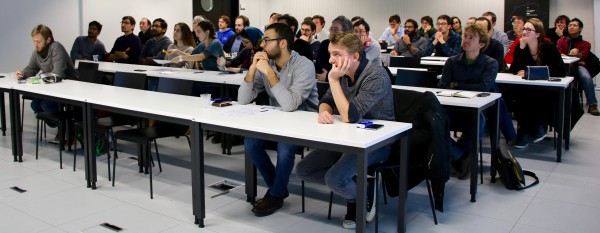MARVEL Junior Seminar — March 2022
https://epfl.zoom.us/j/68368776745
Password: 1923
Each seminar consists of two presentations of 25 minutes each, allowing to present on a scientific question in depth, followed by time for discussion. The discussion is facilitated and timed by the chair.

MARVEL Junior Seminar Organizing Committee — Michele Kotiuga, Sara Fiore, Stefano Falletta, Kristians Cernevics, Max Veit and Patrick Mayor
Talk 1 — Identifying high-stability motifs of structural patterns in molecular crystals
Rose K. Cersonsky1, Maria Pahknova1, Edgar A. Engel2, and Michele Ceriotti1
1 Laboratory of Computational Science and Modeling (COSMO), École Polytechnique Fédérale de Lausanne, Lausanne, Switzerland
2 TCM Group, Cavendish Laboratory, University of Cambridge, UK
Molecular crystals play an important role in various fields of science and industry, with applications in the pharmaceutical, electronics, and food industries. Predicting the stability of crystal structures formed from molecular components is non-trivial, given the complexity inherent to the multiscale nature of their structure and the subtle balance of weak intermolecular interactions governing the structure-property relations. We have curated a dataset containing over 3’000 molecular crystals, their constituent molecules, and their related properties. We use it to demonstrate the use of machine-learning techniques to estimate the stability of the crystalline structures. We use general-purpose descriptors of atomic structure and modify them to explicitly incorporate information on the molecular nature of the material. In combination with a principal covariates regression analysis that explicitly determines the best low-dimensional representation of structure-property relations, we identify the atomic motifs associated with a strong stabilizing effect on molecular packing.
Talk 2 — Metal organic framework based catalysts for the oxygen evolution reaction in alkaline electrolysis
Julia Linke1, Marteen Nachtegaal1, Nicola Casati1, Michal Andrzejewski1, Thomas Rohrbach1, Marco Ranocchiari1, Thomas J. Schmidt1,2, Emiliana Fabbri1
1 Paul Scherrer Institute (PSI)
2 Laboratory of Physical Chemistry, ETH Zürich
Alkaline electrolysis is an appealing technology to produce hydrogen from water using earth-abundant, non-noble metal catalysts. However, because of the slow kinetics of the oxygen evolution reaction (OER) the development of performance stable and active OER catalysts is of great importance for further commercialization of alkaline water electrolyzers. In metal organic frameworks (MOFs) a porous structure is created by linking metal atoms/clusters with other metal centers using organic ligands. The resulting structure with a high surface area and dispersed metal centers is a promising catalyst for OER. MOF-74 catalysts with Ni and Co metal centers show high OER performance stability and impressive OER activity.
Interestingly, Ni-MOF-74 undergoes electronic and structural transformations during stability measurements that result in an increased OER activity. Operando X-ray absorption spectroscopy (XAS) was successfully applied to monitor the changes occurring in the Ni metal centers during OER. The measurements clearly show that Ni-MOF-74 develops into a highly OER active and stable catalytic species. The study focuses on analyzing the nickel oxide, hydroxide and oxyhydroxide species originating from the MOF structure to understand the key structural parameters that lead to such an active species in order to define activity descriptors for the development of highly OER active and stable non-noble metal catalysts for alkaline electrolysis.
Check the list of the next MARVEL Junior Seminars here.
Low-volume newsletters, targeted to the scientific and industrial communities.
Subscribe to our newsletter